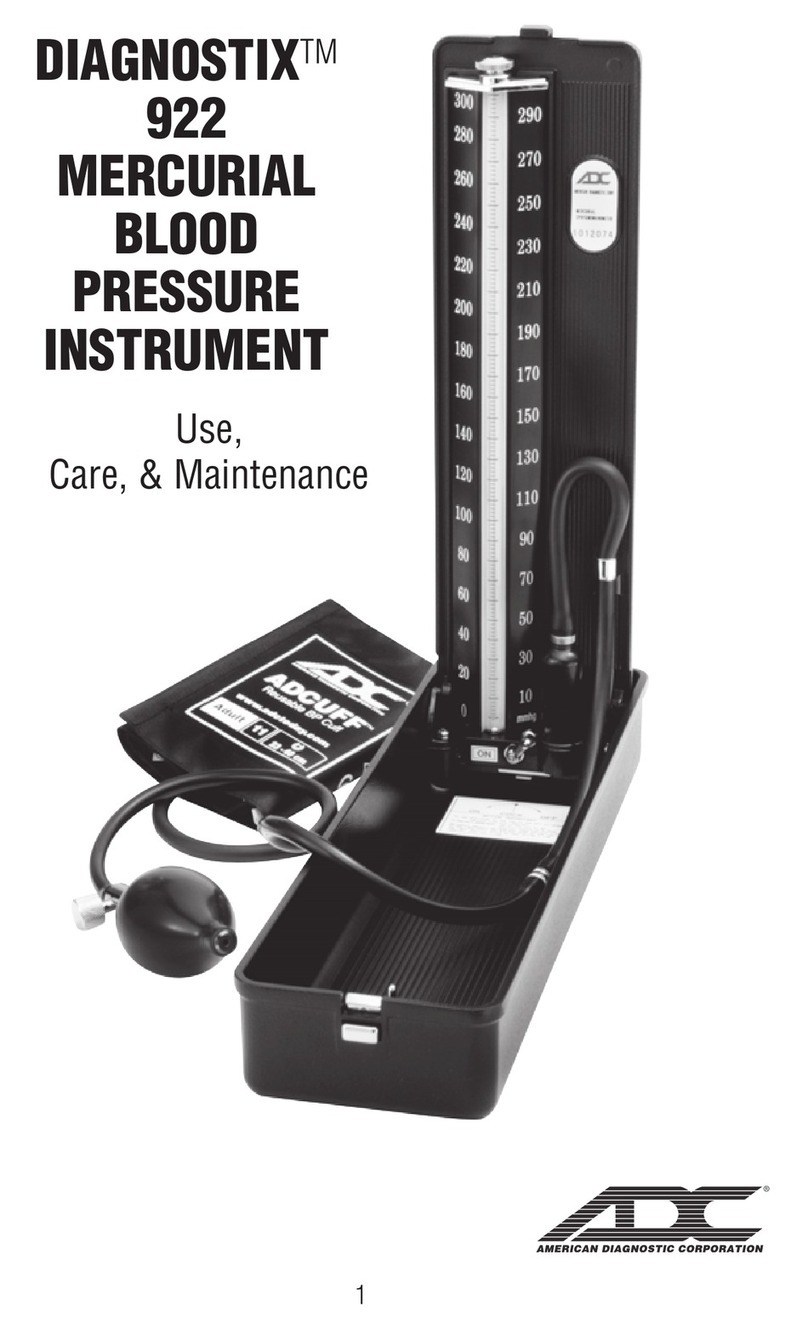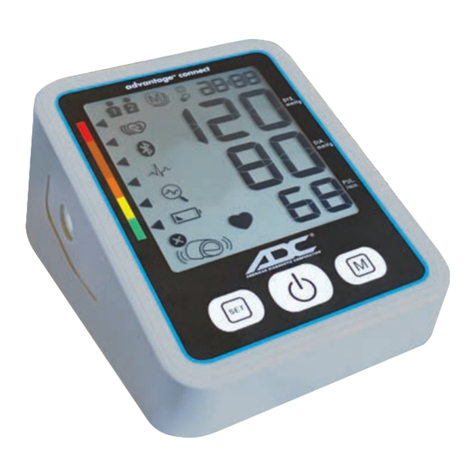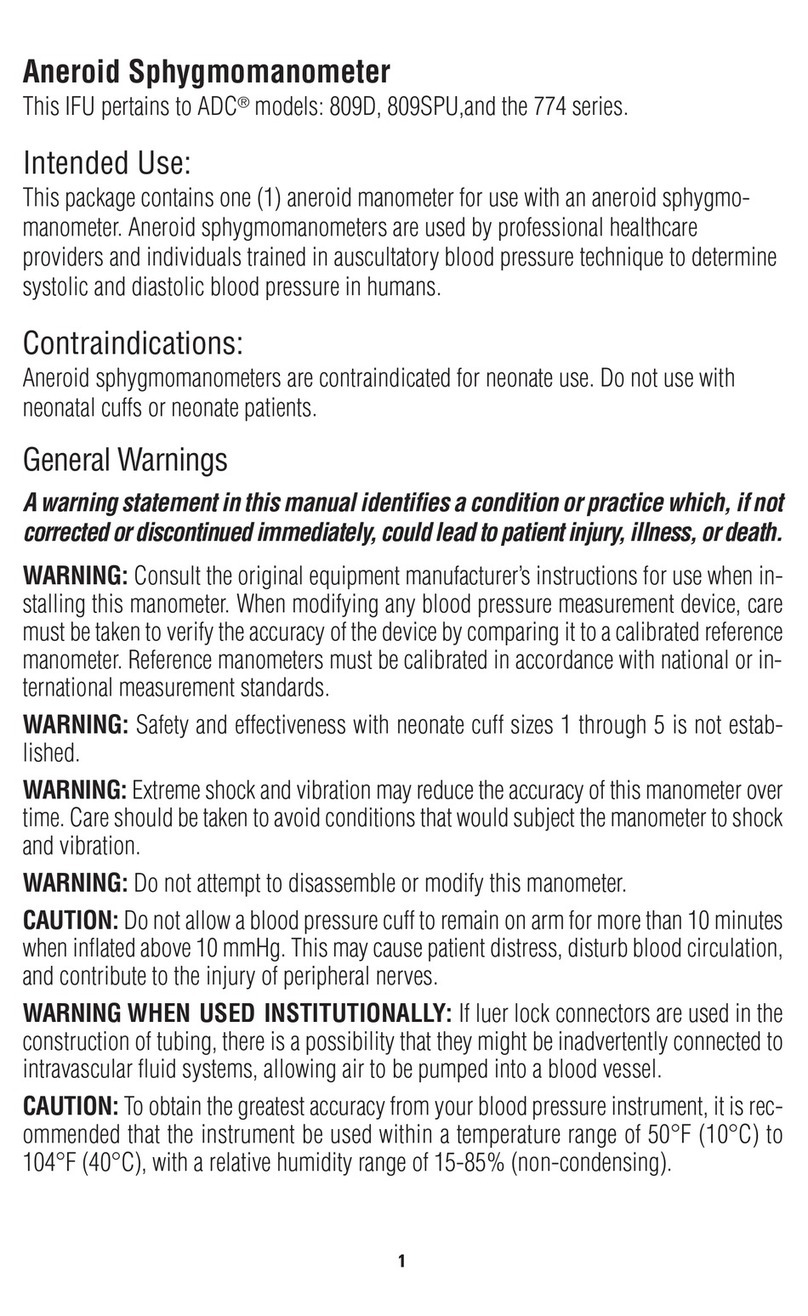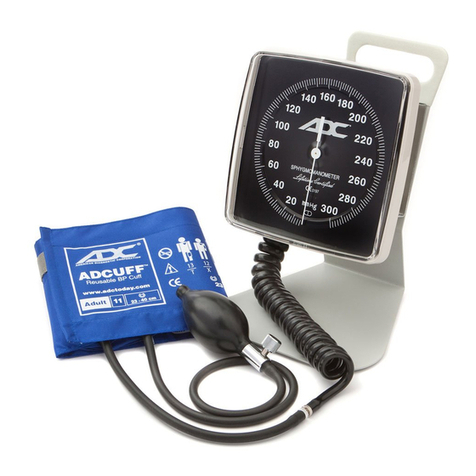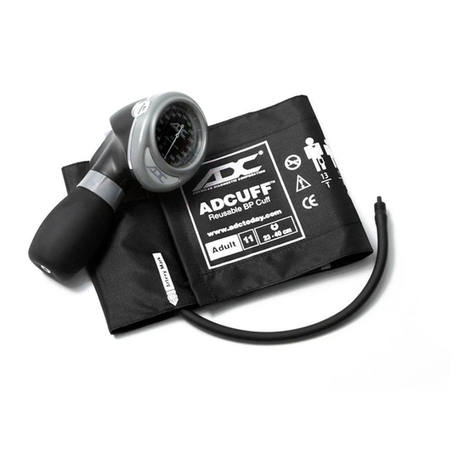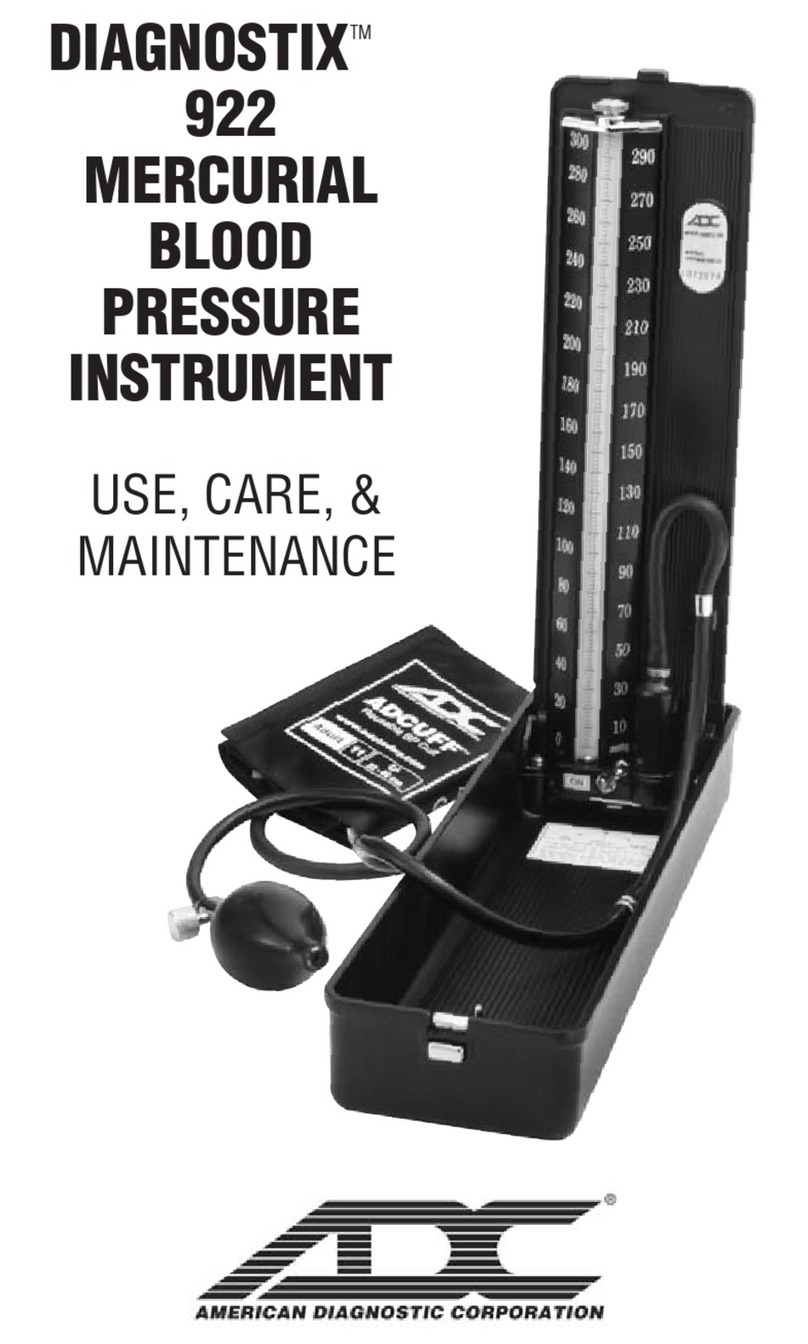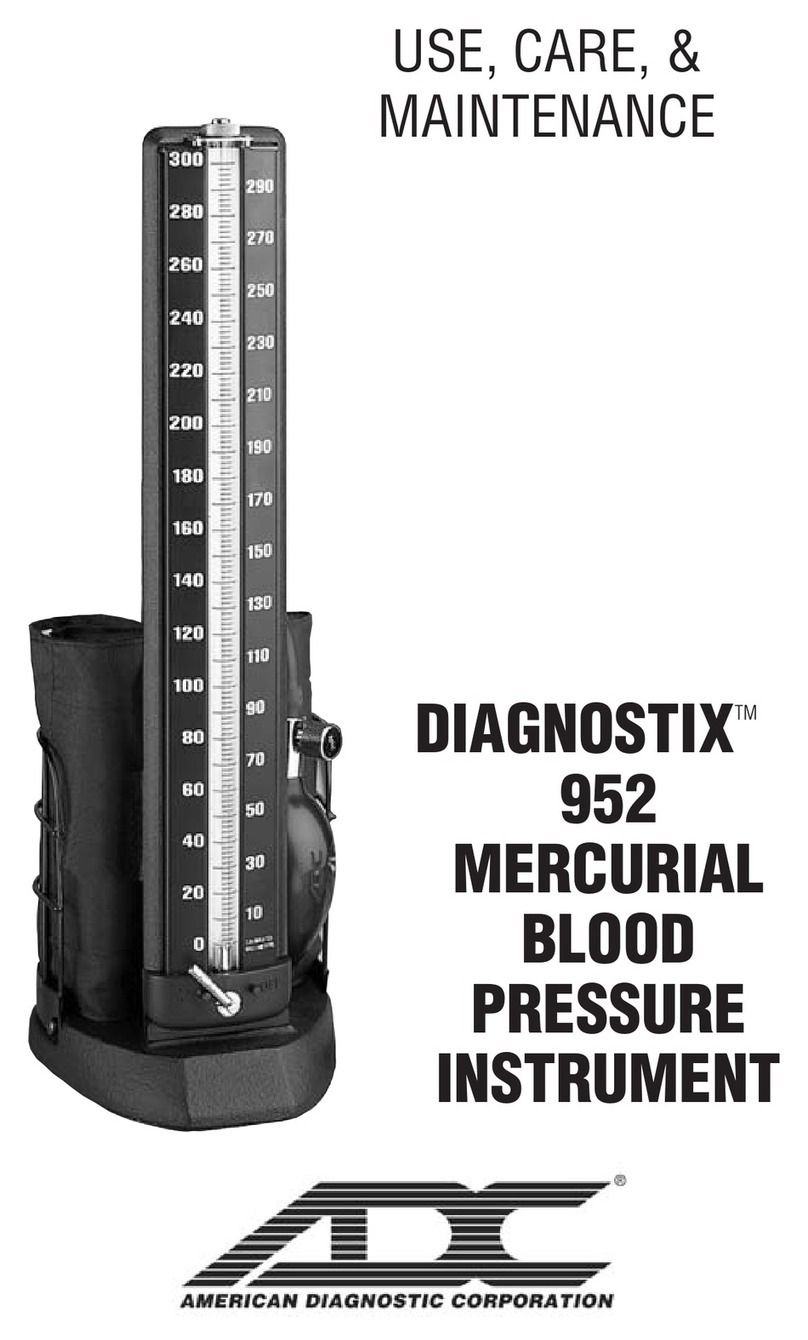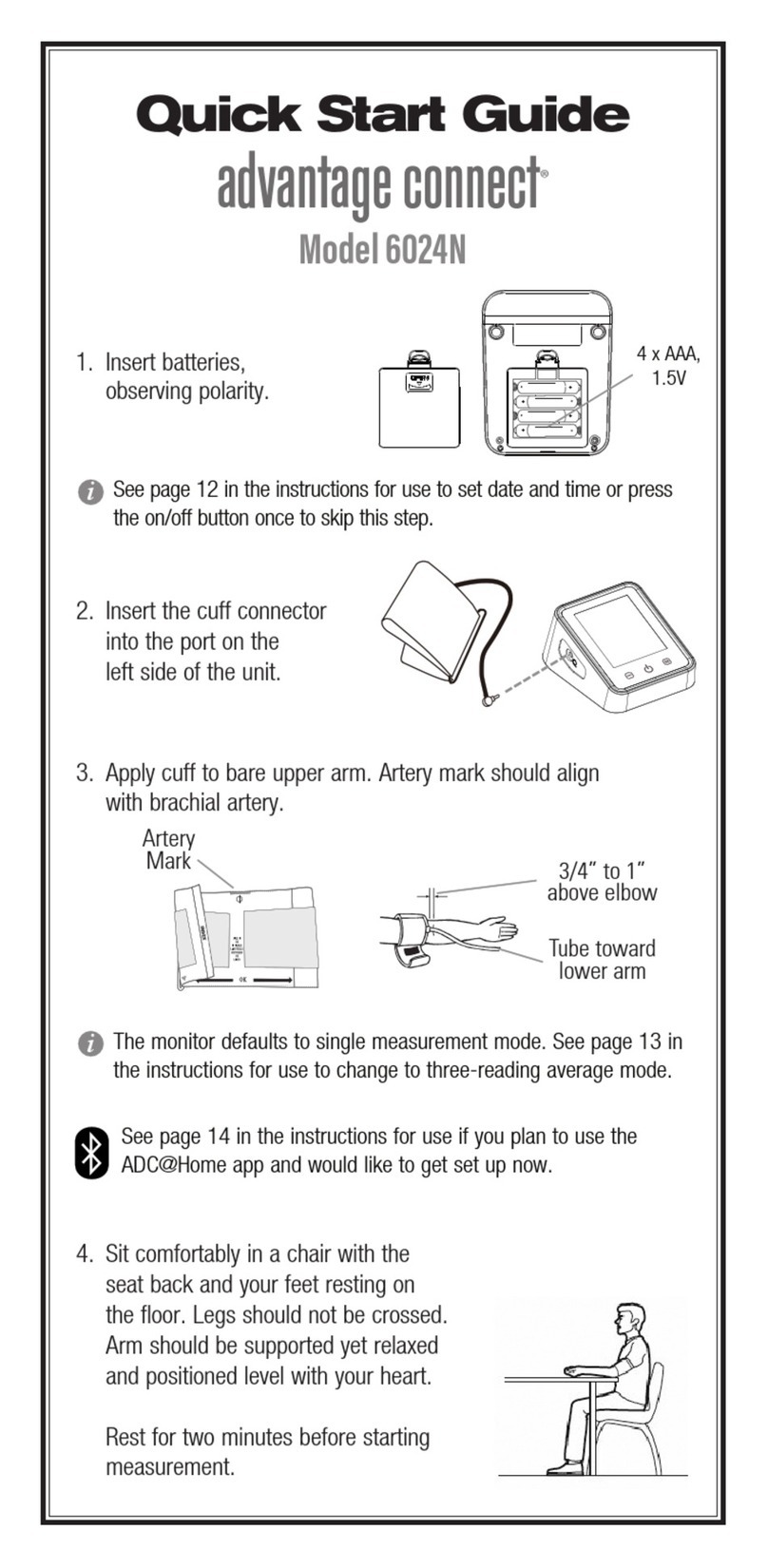
Thank you for choosing an ADC®ProsphygTM Aneroid
sphygmomanometer.
Device Description and Intended Use
An ADC®aneroid sphygmomanometer is used by professional healthcare providers
and individuals trained in the auscultatory blood pressure technique to determine
systolic and diastolic blood pressure in humans.
Contraindications
Aneroid sphygmomanometers are contraindicated for neonate use. Do not use with
neonatal cuffs or neonate patients. Review the size chart (below) for proper limb range.
Symbol Definitions
The following symbols are associated with your ADC sphygmomanometer.
General Warnings
A warning statement in this manual identifies a condition or practice
which, if not corrected or discontinued immediately could lead to patient
injury, illness, or death.
WARNING:
Do not allow a blood pressure cuff to remain on patient for more than 10
minutes when inflated above 10 mmHg. This may cause patient distress, disturb blood
circulation, and contribute to the injury of peripheral nerves.
WARNING:
If luer lock connectors are used in the construction of tubing, there is a
possibility that they might be inadvertently connected to intra-vascular fluid systems,
allowing air to be pumped into a blood vessel. Immediately consult a physician if this occurs.
WARNING: Safety and effectiveness with neonate cuff sizes 1 through 5 is not established.
WARNING: If this equipment is modified, appropriate inspection and testing must be
conducted to ensure its continued safe use.
WARNING: Do not apply cuff to delicate or damaged skin. Check cuff site frequently
for irritation.
WARNING: Only use the cuff when the range markings indicated on the cuff show that
the proper cuff size is selected, otherwise erroneous readings may result.
WARNING: Allow space between patient and cuff. Two fingers should fit in this space
if the cuff is correctly positioned.
WARNING: Do not apply cuff to limbs used for IV infusion.
WARNING: Patient should remain still during measurement to avoid erroneous readings.
WARNING: When using with an infant or child cuff, extra care must be taken to
prevent over-inflation. With smaller cuffs (infant or child) the cuff can inflate to over
300mmHg with just two full compressions of the bulb. To prevent discomfort or injury
to the patient and damage to the instrument, bulb should only be partially squeezed,
so that each “stroke” inflates the cuff in 40mmHg to 60mmHg increments until inflated
to the desired level.
CAUTION:
To obtain the greatest accuracy from your blood pressure instrument, it is
recommended that the instrument be used within a temperature range of 50°F to
104°F (10°C to 40°C), with a relative humidity range of 15%-85% (non-condensing).
CAUTION: Extreme altitudes may affect blood pressure readings. Your device has
been designed for normal environmental conditions.
Operation of Pocket Aneroids
This booklet contains operating and
maintenance information for pocket aneroid
sphygmomanometers. Please read and retain.
Your pocket aneroid
sphygmomanometer consists of
an aneroid manometer (gauge),
complete inflation system,
(latex-free inflation bladder, squeeze bulb,
and the valve), a zippered carrying case,
and operating instructions.
Most models are preassembled and ready for use.
In units requiring assembly, the bulb and valve should connect
to the tube closest to the Index Line. The gauge connects to the remaining tube.
Apply a small amount of alcohol or soapy water to tubing if needed.
Measurement Procedure
Patient Position
The patient should sit or lie comfortably. The arm should be fully supported on a flat
surface at heart level. (If the arm’s position varies, or is not level with the heart, meas-
urement values obtained will not be consistent with the patient’s true blood pressure.)
When seated, the patient should have their back and arm supported, and their legs
should not be crossed. The patient should relax prior to measurement comfortably
for five minutes and should refrain from talking or moving during measurement.
Observer should view manometer in a direct line to avoid “parallax error.”
Apply the Cuff
Nylon cuffs are specially designed to
promote the precisely accurate
determination of blood pressure.
Index and range markings ensure use
of the correct cuff size. The artery mark
indicates proper cuff positioning.
Place the cuff over the bare upper arm with
the artery mark positioned directly over the
brachial artery. The bottom edge of the cuff should be positioned approximately one
inch (2-3cm) above the antecubital fold. Wrap the end of the cuff not containing
the bladder around the arm snugly and smoothly and engage adhesive strips
(Figure 1).
NOTE: If the unit is
equipped with a calibrated
nylon cuff, featuring Index
and Range markings, a cor-
rect fit may be verified by
checking that the Index Line
falls between the two Range
Lines. (Figure 2).
Inflate the Cuff
Close the valve by turning thumbscrew clockwise.
Palpate the radial artery while inflating the cuff. Be sure to inflate cuff quickly by
squeezing bulb rapidly.
Inflate cuff 20-30 mmHg above the point at which the radial pulse disappears.
NOTE: Cuff pressure range is 0 mmHg to 300 mmHg.
Position the Stethoscope
Position the chestpiece in the antecubital space below the cuff, distal to the brachium.
Do not place chestpiece underneath the cuff, as this impedes accurate measurement.
Use the bell side of a combination stethoscope for clearest detection of the low pitched
Korotkoff (pulse) sounds.
Deflate the Cuff
Open the valve to deflate the cuff gradually at a rate of 2-3 mmHg per second.
Measurement
Record the onset of Korotkoff sounds as the systolic pressure, and the disappearance
of these sounds as diastolic pressure. (Some healthcare professionals recommend
recording diastolic 1 and diastolic 2. Diastolic one occurs at phase 4.)
NOTE: It is recommended that K4 be used in children aged 3 to 12, and K5 should be
used for pregnant patients unless sounds are audible with the cuff deflated, in which
case K4 should be used. K5 should be used for all other adult patients.
After measurement is completed, open valve fully to release any remaining air in the
cuff. Remove cuff.
Care and Maintenance
STORAGE
Pocket Gauge: After measurement, fully exhaust cuff then wrap cuff around gauge
and bulb and store in zippered carrying case.
NOTE: This product will maintain the safety and performance characteristics
specified at temperatures ranging from 50°F to 104°F (10°C to 40°C) at a relative
humidity level of 15% to 85%.
This device can be safely stored at temperatures ranging from -4°F to 158°F
(-20°C to 70°C) with a relative humidity of 85% or below.
Manometer: Your pocket aneroid gauge requires minimal care and maintenance.
The manometer may be cleaned with a soft cloth but should not be dismantled under
any circumstances.
Should the indicator needle of the manometer rest
outside the oval calibration mark (Figure 3), then
the manometer must be re-calibrated to within ±3
mmHg when compared to a reference device that
has been certified to national or international
measurement standards. A manometer whose
indicator needle is resting outside of this mark
is NOT acceptable for use.
In the event that the gauge is ever in need of calibration, simply return for service.
Damaged or broken parts will be replaced as needed at a minimal charge. Refer to the
warranty for specific details of warranty coverage.
The manufacturer recommends a calibration check every 2 years.
Cuff Size Limb Range
Inches CM
Infant 7I 3.5 to 5.5 9 to 14
Child 9C 5.1 to 7.6 13 to 19.5
Sm. Adult 10SA 7.4 to 10.6 19 to 27
Adult 11A 9 to 15.7 23 to 40
Lg. Adult 12X 13.3 to 19.6 34 to 50
Thigh 13T 15.7 to 25.9 40 to 66
Adcuff Series Size Chart
Range Lines
Index Lines
NOTE: Store gauge with
valve in full exhaust position.
(Figure 3)
(Figure 2)
Cuff
Index Line
Hang
Tab
Gauge
Artery Mark
Bulb & Valve
Bladder &
Tubing
Left Arm
Tube
(Figure 1)
Symbol Definition
Important Warning/Caution
Not made with natural rubber latex
Circumference Size
Meets essentials requirements of
European Medical Device Directive
93/42/EEC
Consult instructions for use
Symbol Definition
Authorized European Representative’s
Information
Manufacturer’s Information
Temperature Limit
Humidity Limitation
Medical Device
Cuff Size Limb Range
Inches CM
Sm. Adult 10SA 6.3 to 9.8 16 to 25
Adult 11A 9 to 13.3 23 to 34
Lg. Adult 12X 11.8 to 15.7 30 to 40
780-790 Series Size Chart
9360N-00 rev 13.qxp_Layout 1 9/2/21 3:30 PM Page 2
